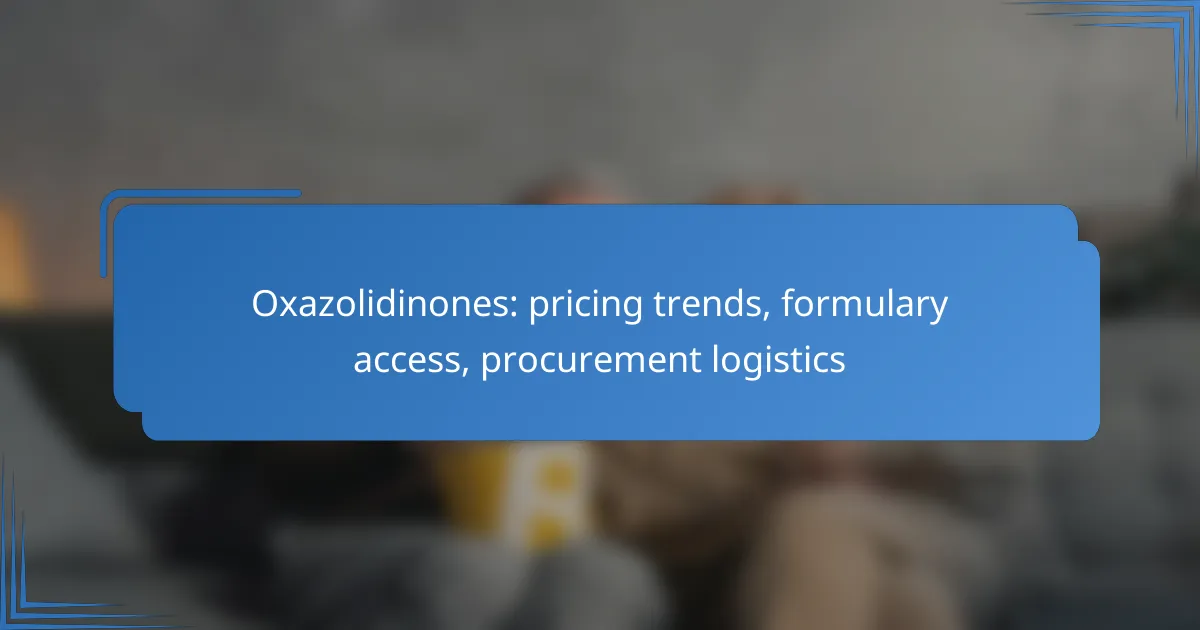Oxazolidinones, vital antibiotics for treating specific infections, have experienced a moderate price increase in Canada over the past year due to various market factors. Access to these medications is facilitated through healthcare providers’ formularies, which evaluate efficacy, safety, and cost-effectiveness. Efficient procurement logistics, encompassing sourcing, purchasing, and distribution, are essential for ensuring timely availability while adhering to regulatory standards.

What are the current pricing trends for Oxazolidinones in Canada?
In Canada, pricing trends for Oxazolidinones have shown a moderate increase over the past year, influenced by various market factors. These antibiotics are essential for treating certain infections, and their costs can vary significantly based on supply chain dynamics and healthcare policies.
Price fluctuations in 2023
Throughout 2023, the prices of Oxazolidinones have experienced fluctuations due to changes in demand and supply chain disruptions. For instance, prices have risen by approximately 5% to 10% in certain provinces, reflecting increased production costs and limited availability. This trend is expected to continue as manufacturers adjust to market conditions.
Additionally, the introduction of new generics has the potential to stabilize prices, although the impact may vary regionally. Healthcare providers should monitor these changes closely to manage procurement effectively.
Comparative pricing with other antibiotics
When compared to other antibiotics, Oxazolidinones tend to be on the higher end of the pricing spectrum. For example, while common antibiotics like amoxicillin may cost around CAD 10 to CAD 30 for a course of treatment, Oxazolidinones can range from CAD 100 to CAD 300, depending on the specific drug and dosage. This significant difference highlights the specialized nature of Oxazolidinones.
Healthcare professionals should consider these costs when prescribing treatments, especially in budget-sensitive environments. Understanding the pricing landscape can aid in making informed decisions about patient care.
Factors influencing pricing
Several factors influence the pricing of Oxazolidinones in Canada, including manufacturing costs, regulatory changes, and market demand. The complexity of the production process often leads to higher prices, as these drugs require advanced technology and stringent quality controls.
Additionally, government policies and reimbursement rates can affect how much hospitals and pharmacies pay for these medications. Keeping abreast of changes in healthcare regulations and market trends is crucial for stakeholders involved in procurement and formulary management.

How can healthcare providers access Oxazolidinones formulary?
Healthcare providers can access Oxazolidinones through their institution’s formulary, which outlines approved medications based on efficacy, safety, and cost-effectiveness. Access typically involves a review process that considers clinical guidelines and patient needs.
Formulary inclusion criteria
Formulary inclusion for Oxazolidinones generally requires evidence of clinical effectiveness against specific infections, such as multi-drug resistant Gram-positive bacteria. Cost considerations, including the drug’s price relative to alternatives, also play a significant role in the decision-making process.
Healthcare institutions often evaluate Oxazolidinones based on guidelines from organizations like the Infectious Diseases Society of America (IDSA). Additionally, formulary committees may require documentation of patient outcomes to support ongoing access.
Provincial differences in access
Access to Oxazolidinones can vary significantly across provinces due to differing healthcare policies and formulary management practices. For instance, some provinces may have more restrictive criteria, limiting access to specific patient populations or requiring prior authorization.
In Canada, provincial drug benefit programs may influence the availability of Oxazolidinones, with some regions offering broader access than others. Healthcare providers should familiarize themselves with local regulations and formulary listings to ensure appropriate prescribing and patient access.

What are the procurement logistics for Oxazolidinones?
Procurement logistics for oxazolidinones involve the processes of sourcing, purchasing, and distributing these antibiotics efficiently. Key factors include supply chain management, distribution channels, and regulatory compliance, which all play crucial roles in ensuring timely access to these medications.
Supply chain considerations
When managing the supply chain for oxazolidinones, it is essential to consider factors such as supplier reliability, inventory levels, and lead times. Establishing strong relationships with manufacturers can help mitigate risks related to shortages and ensure consistent product availability.
Additionally, monitoring market trends and pricing fluctuations is vital. For instance, understanding the impact of raw material costs can aid in forecasting potential price changes and adjusting procurement strategies accordingly.
Distribution channels in Canada
In Canada, distribution channels for oxazolidinones typically include wholesalers, pharmacies, and hospitals. Wholesalers play a significant role in bridging the gap between manufacturers and healthcare providers, ensuring that medications are readily available where needed.
Healthcare facilities must navigate regulations set by Health Canada, which govern the storage and distribution of pharmaceuticals. It is crucial to maintain compliance with these regulations to avoid penalties and ensure patient safety. Regular audits and training for staff can help maintain adherence to these standards.

What are the challenges in procuring Oxazolidinones?
Procuring oxazolidinones presents several challenges, including regulatory hurdles and market availability issues. These factors can significantly impact access and pricing for healthcare providers and patients.
Regulatory hurdles
Regulatory hurdles often complicate the procurement of oxazolidinones. These medications must comply with strict guidelines set by health authorities, which can vary by country. For instance, in the European Union, oxazolidinones are subject to rigorous evaluation processes that can delay market entry.
Healthcare providers should stay informed about the regulatory landscape to anticipate potential delays. Understanding the specific requirements for drug approval and distribution can help streamline the procurement process.
Market availability issues
Market availability issues can arise due to limited manufacturers or supply chain disruptions. Oxazolidinones may not be readily available in certain regions, leading to increased prices and potential shortages. For example, in some countries, only a few suppliers may offer these drugs, creating a dependency that can affect procurement strategies.
To mitigate these challenges, healthcare facilities should establish relationships with multiple suppliers and consider alternative sourcing options. Regularly reviewing market conditions and maintaining flexibility in procurement plans can help ensure consistent access to oxazolidinones.

How do Oxazolidinones compare to other antibiotic classes?
Oxazolidinones are a unique class of antibiotics that are particularly effective against certain resistant bacteria, setting them apart from traditional antibiotics. Their mechanism of action and specific use cases make them a valuable option in the treatment of multidrug-resistant infections.
Efficacy against resistant bacteria
Oxazolidinones, such as linezolid, are specifically designed to combat resistant strains of bacteria, including methicillin-resistant Staphylococcus aureus (MRSA) and vancomycin-resistant Enterococcus (VRE). Their ability to inhibit protein synthesis makes them effective where other antibiotic classes may fail.
In clinical settings, oxazolidinones have shown significant success in treating complicated skin and soft tissue infections as well as pneumonia caused by resistant organisms. Their targeted efficacy is crucial in managing infections that do not respond to standard treatments.
Cost-effectiveness analysis
The cost of oxazolidinones can be higher than that of many other antibiotic classes, often exceeding several hundred dollars for a course of treatment. However, when considering the potential for reduced hospital stays and complications associated with resistant infections, their cost-effectiveness improves significantly.
Healthcare providers should weigh the upfront costs against the long-term savings from preventing treatment failures and the need for more expensive alternatives. In some cases, using oxazolidinones may lead to overall lower healthcare costs due to their effectiveness in treating resistant infections promptly.

What are the emerging trends in Oxazolidinones usage?
Emerging trends in the usage of oxazolidinones indicate a significant increase in prescriptions, particularly for specific patient demographics. These antibiotics are gaining attention for their effectiveness against resistant bacterial infections, prompting healthcare providers to consider them more frequently in treatment plans.
Increased prescriptions in specific demographics
Recent data shows that oxazolidinones are increasingly prescribed to older adults and patients with chronic conditions, such as diabetes or cancer. This demographic often faces higher risks of infections due to weakened immune systems, making effective treatment options crucial.
Healthcare providers are also focusing on patients with multi-drug resistant infections, where oxazolidinones offer a valuable alternative. The growing prevalence of antibiotic resistance is driving this trend, as clinicians seek effective therapies to combat these challenging infections.
Future research directions
Future research on oxazolidinones is likely to explore their long-term efficacy and safety profiles, especially in vulnerable populations. Investigations may include clinical trials aimed at understanding the optimal dosing strategies and potential side effects over extended use.
Additionally, studies may focus on the development of new formulations or combinations with other antibiotics to enhance effectiveness. As resistance patterns evolve, ongoing research will be essential to adapt treatment protocols and ensure the continued utility of oxazolidinones in clinical practice.
